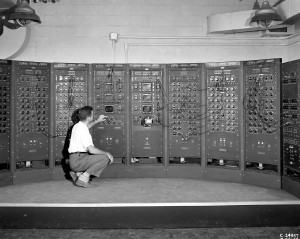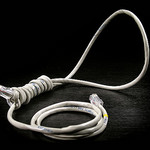People get excited about technology. They always have.
Parents realize their children are completely engaged by blue-glowing screens at every spare moment, and so they suggest that their child would do more assignments and pay more attention if more technology were used. Anyone who’s ever seen a two-year old pick up a new smart device and navigate to Angry Birds in 30 seconds will tell you that technology is intuitive and kids adapt to it so quickly, so you should leverage that in the classroom. Politicians of all parties build platforms based on expanding technology in our classrooms so that we can meet the demands of our global community. Technology clearly seems to be the answer to a lot of our educational problems.
I use technology often in my everyday life. I’m fairly young, so having it ever-present in my life is natural to me. In fact, there are six internet ready devices in the room I’m sitting in right now in my house–six, I tell you! And trying new things in the classroom doesn’t daunt me. I trust my students and have great classroom culture. I want them to be engaged. I watched this video at a staff meeting in every school I’ve ever taught at. I get it. So why is it rare to see the children using technology (watching my cast-ups on an LCD projector doesn’t count) when you walk by my classroom, then?
1. Availability
Baffling though it may be in this day and age, not every child has access to a computer at home. Or the computer may be there, but it’s offline. The kids may have a smart phone, so might their parents, but no functional computer. Solution: Bridge that gap through schools. But even that’s not so easy. Not every district has or has allocated the funds for a 1-to-1 initiative. In my school, we share one laptop cart of 18 computers across two grade levels. Every class wants them. Our class sizes are larger than 18. No promises that all 18 machines will function at once. And this is a big step up above my last school. My previous middle school had only one computer lab and it was usually occupied by Reading Academy, a mandatory elective for students with low EOG reading scores. And inexplicably, in every school I’ve ever studied or taught in, almost every class has one or two computers, there gathering dust, that just ”don’t work”.
Bottom line: It’s hard to use technology when it’s not there.
2. Accessibility
So we can dream of a day when there’s an iPad cart for every two classes, or when there’s a clicker for every kid. Bright, shiny new machines for everyone. But the challenge of the internet connection reigns. Internet in educational buildings works in a way I have never understood. Bizarre things happen. Certain rooms are black holes of internet connectivity (mine is). Sometimes the internet goes out after 1:00pm exactly. It seems to vary with the weather. Or if someone laughs too loudly. And when too much activity is going on at once, nothing will work. The kids have their own ways of trouble shooting:
”There’s a switch on the side, did you bump it?”
”Open the connections and disconnect and reconnect. Make sure you’re not on the guest network”
”You have too many tabs open, man. Just close them all except one”
”Use Google Chrome! It doesn’t like Internet Explorer!”
”Use Internet Explorer! It doesn’t like Google Chrome!”
”Ctrl-Alt-Del, dude”
”Mine’s stuck, can I share with Daniel?”
”Ms. Bolton, can I just use your computer?”
But there’s very little on their part that can fix a weak connection. Bottom line: It’s hard to connect with the world when everyone can’t connect.
3. Buy-in
So, we wait for every politician’s platform promise and every district initiative to come to fruition, and someday along with all our shiny tablets, we’ll have excellent connectivity and limitless bandwidths in every school. We’d still have a battle to fight, and this battle for me is the hardest to address. Putting the whole internet, with all human knowledge and art, at a kid’s fingertips gives kids a great deal of power. But schools don’t always trust their kids to use that power wisely. And then come the blocks. It starts with social media, which makes sense. I understand the reasoning behind blocking social media, but it evolves so quickly that administration may block something that kids have abandoned (Facebook) but ignore something the kids are all into (AskFM).
Then it snowballs….”youtube” is inevitably next, which is heartbreaking. Youtube is a great tool when used correctly–with previewing by teachers. Sure, there’s Schooltube and Teachertube, but they’re not the same. Administrations fear the comments section most, but you can use web clipping tools like Splicd, or just scroll the comments out of frame.
Search blocks can also get out of control. I know of one school where in an attempt to block all internet radio stations, they have a web filter that doesn’t allow you to do a web search for anything with the word ”music”. You can imagine the trouble this may cause.
My school has on average a fairly affluent population, all things considered, which lends itself well to a Bring Your Own Device policy. But I fear we’ll never get it instated because our middle schoolers have made some poor decisions with instant share apps like Vine and Snapchat. I’ve had extensive consequences with my students about this, and about monitoring your own online presence. I understand wanting to keep children socially safe and limiting distractions during instructional time. But ultimately I stand with giving freedoms. Ignoring the technology that kids do have and keeping smart devices out of classrooms is a little like an art teacher planning on sticking to pencils today because he’s afraid students will make a mess with paint or create anatomically accurate sculptures with clay. Technology can be a creative medium if we let it.
We’re educators. We have been for years. I believe we should do with technology what we’ve done with everything in classrooms: introduce it proactively. Establish clear procedures and communicate them. Provide positive and negative consequences for whether those procedures are followed. And adapt.
What do you think? Do the possibilities and potential behind technology and using smart devices in the classroom outweigh the hazards that come with them (inappropriate usage, cyber bullying, and accidental exposure to mature information/images, etc)?
photo credit: <a href=”http://www.flickr.com/photos/x-ray_delta_one/7751056502/”>x-ray delta one</a> via <a href=”http://photopin.com”>photopin</a> <a href=”http://creativecommons.org/licenses/by-nc-sa/2.0/”>cc</a>
photo credit: <a href=”http://www.flickr.com/photos/extraketchup/622612084/”>Extra Ketchup</a> via <a href=”http://photopin.com”>photopin</a> <a href=”http://creativecommons.org/licenses/by-sa/2.0/”>cc</a>
photo credit: <a href=”http://www.flickr.com/photos/donsolo/2855854548/”>Ѕolo</a> via <a href=”http://photopin.com”>photopin</a> <a href=”http://creativecommons.org/licenses/by-nc-sa/2.0/”>cc</a>
photo credit: <a href=”http://www.flickr.com/photos/xul/1226982752/”>zaqi</a> via <a href=”http://photopin.com”>photopin</a> <a href=”http://creativecommons.org/licenses/by-sa/2.0/”>cc</a>




Love how you captured the sounds of students trouble-shooting. I work at a school that allows students to bring and use their own devices with teacher permission and discretion. We do worry about the hazards, but we feel teaching students how to use the device to aid their learning outweighs the hazards.
After talking with Jason at NCCAT and some other people with BYOD policies at their schools, it’s sort of my mission to get my school to adopt one this year. We’ll see how it goes.
Wonderful blog entry! Love your breakdown on the topic.
Amneris